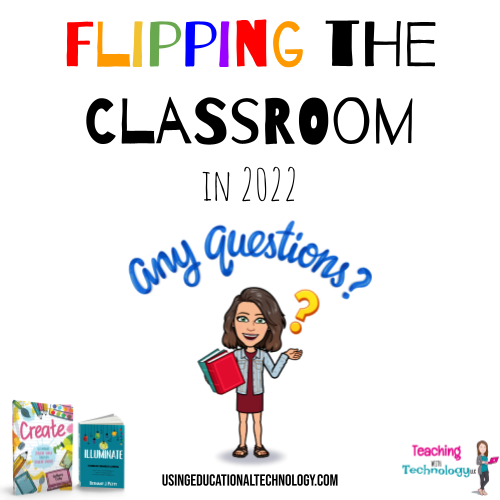Heyyyy, all! Happy Sunday! I hope you’re having a great weekend and are able to enjoy some much-needed and well-deserved rest after what I’m sure has been a hectic, challenging, and hopefully rewarding week in the classroom! This is the first weekend in recent memory that I’m NOT taxiing my daughters all over God’s creation to basketball games, volleyball tournaments, or school events. I’m fine! It’s all fine! Thank you, Lord, for coffee! If you’ve followed my blog for a bit (thanks!) you know that I am a HUGE proponent of flipping the classroom. If you’ve ever heard me speak or attended one of my workshops/seminars (again, thanks!) you know that I absolutely LOVE sharing my experiences with this instructional strategy. I always feel like I run out of time, though, when I’m speaking in person about this strategy, because I want to share soooo many things 🙂 So, I decided that it’s time to share an updated post with you about what in the world my flipped classroom looks like in 2022. Let’s do this!
First, let’s identify exactly what flipped learning actually is. According to Flipped Learning Global,
“Flipped Learning is a framework that enables educators to reach every student. The Flipped approach inverts the traditional classroom model by introducing course concepts before class, allowing educators to use class time to guide each student through active, practical, innovative applications of the course principles.“
I feel like the first line of this definition is most powerful and was the driving force behind my desire to flip my classroom in 2014. As a teacher, one of my many goals is to reach all of my students every day – we know that’s a lofty, and most likely an unattainable goal, but by golly, I’m going to try!
When I started flipping my classroom in 2014, I used the “traditional” flipping method which involves students viewing video content at home and then coming into the classroom the next day to review and apply what they learned in the video.
This worked just fine for a few days until …
– my students pointed out that my videos were super long (the longest was 18 minutes 😱)
– I realized more and more of my students weren’t watching the videos at home and were just copying notes from a classmate
– one of my students told me she didn’t finish her video at home and was about to proceed to the “corner of shame” (which was apparently the nickname my students had given the table in the rear of the classroom where I told them to finish their videos – with no punishment! – before they could join their peers for an application assignment) to finish her video
When I heard that last comment, I immediately slammed on my teacher brakes and knew I needed to reflect on the progress I was making toward my goal of giving reaching every student.
After some thinking, I realized the traditional flip just wasn’t going to be effective for my students in my classroom. Around the same time, I read an article on one of my favorite educational websites, Edutopia, about a variation of the flipped classroom, called the “in-class” flip, which I call “the flipped flipped classroom.” Be sure to check out the article here if you’d like to see what sparked my strategy!
Here’s a glimpse into a typical “flipped flip” day in my classroom.
1️⃣ After attendance is taken (when I remember 🤣) my students and I discuss our learning target and tasks for the day
2️⃣ Students go to one of my FAVORITE tools, Edpuzzle, and open their instructional video for the day. Then, they head over to Classroom and open their unit interactive guided notes (some of them take my advice and bookmark their notes so they DON’T have to go to Classroom, but that’s another discussion for another day!)
3️⃣ When students have finished the video (I give them double the time of the video to complete the video assignment) we do a “deep dive” into the content they’ve just learned, discussing, applying, and extending the content.
4️⃣ Next, we play a class game of Kahoot, Quizizz, Blooket, Quizlet Live, or the like to review the content and clear up any misconceptions
*Note, sometimes we flip (pun intended!) steps 3 and 4*
5️⃣ Before the bell rings, students are working on something collaboratively to help them apply what they’ve learned. This could be a drag and drop assignment, pixel art review, a reflection question on Classroom, or a quick “rate your comfort level with this statement (insert success criteria here)”
That’s it! That’s a typical flipped day in my flipped classroom! Now, a few questions I’m always asked …
“Do your students watch a video every day?”
“How many videos do you have per unit?”
“Do you make all of the videos?”
“Are you ‘in’ the videos?”
“How long are your videos?”
“Do you remake the videos every year?”
I’ll be answering these questions AND providing examples and resources in the next few days!
What other questions should I answer? Let me know!
Thanks for reading 🙂


Hey Bethany! I am very intrigued by your flipped classroom. I like the idea of sharing instructional videos before class starts. How do you hold students accountable with their notes? I would love to see how you have students dive deeper into their understanding.
Hey, Kelsey!
I provide my students with interactive guided notes at the beginning of each unit. I give them the choice of taking their notes digitally on Classroom or on a printed copy I provide. Some students choose to create their own notes, which is also totally fine! When we do our deep dive, students access their notes and add to them to clarify or extend their understanding of the content. I’ll share a new post with more info soon!
Thanks for stopping by!
Bethany
Using technology in the teaching and learning process help students to be a well rounded individual catering to his or her needs. My students also enjoy playing these games. They started out first with Blooket and when they were introduced to Quizizz during their intervention, they enjoyed playing both. Great resources for students to learning all subject areas from.
Bethany,
I have been wanting to implement the flipped classroom, but I kept hitting a roadblock because I know my students, and they WILL NOT (or cannot) watch a video at home. The traditional method is not practical for my learners, but your alternative method has given me new hope. Thank you for sharing!
That’s great news, Jana! Please share your updates!